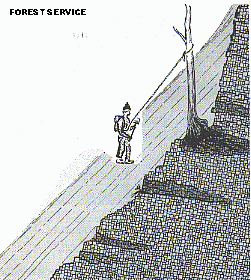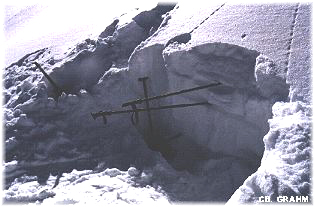This article first appeared on Colorado Firstrax, a site that began in 1995 and was run by David Sauer. The website disappeared rather abruptly without any trace. In June, 2006 a copy of much of the site as of 2001 was uncovered at web.archive.org and the avalanche section was recovered and archived here.
Identifying Weak Layers in a Snow Pit
David Sauer, originally for Firstrax
Digging a snow pit is time consuming and not particularly much fun. But it could be very wise. The first dilemma you will run into is this:
The best place to dig the pit is in the release zone. But the action of you being there digging may trigger the thing to slide.
 The best answer to this is that the digger is on a rope anchored to a tree or something solid. You needn't carry 165 feet of 11mm. perlon but any rope is bulk and weight and let's face it, few people carry ropes unless they are skiing to or from a technical ascent. If you pack a short 9mm. rope that's great.
The best answer to this is that the digger is on a rope anchored to a tree or something solid. You needn't carry 165 feet of 11mm. perlon but any rope is bulk and weight and let's face it, few people carry ropes unless they are skiing to or from a technical ascent. If you pack a short 9mm. rope that's great.
If you don't have a rope, or there's no object to tie off to, you must dig the pit somewhere else or take your chances. Is the place you are digging representative of the snowpack at the trigger zone? That's a tough question. You have to consider variables like wind and sun exposure.
You can dig more than one pit, using different exposures. Consider there is no limit to how much information you could collect from pits. It's a matter of time and judgement as to what's sufficient.
Dig the pit wide enough so that you can get into it somewhat and check out the bottom layers. In Colorado, a continental region rather than maritime, the worst TG snow will most likely be at the very bottom. [See "Early Season Avalanche Notes" for discussion of this. (Unfortunately the early season article was not in the web archives and is currently unavailable. - Avalanche Center)]
How deep should you dig if the snowpack is very deep? Some say it is not worth digging more than 6 feet. Below 6 feet they feel the impact of your skiing is insignificant as a trigger. But is the slope ready to let loose on it's own due to a layer of depth hoar just above the ground?
 After digging this pit, smooth the upper wall with your shovel. If you have a brush sweep it side to side to bring out the layers. What should you look for?
After digging this pit, smooth the upper wall with your shovel. If you have a brush sweep it side to side to bring out the layers. What should you look for?
Look for TG snow just above the ground as is typical for Colorado. Is it really bad depth hoar like sugar or sand? That would clearly rule out safe skiing. A little bit of TG would not be so bad because the grains would have cohesion for one another. A hand lens and a black plastic surface to set the snow on is almost necessary to identify minimal or moderate TG grains. Severe TG (depth hoar) is obvious without a lens.
You should look for other things in addition to TG snow. The snow above a crust could slide on that crust's upper surface. The crust layer could be an obvious sun crust that is hard or a subtle wind crust you might miss without careful brushing. What is the snow like right above that crust? It is this snow that must have cohesion. If it is a graupel layer it may act like small ball bearings. If it is surface hoar, the little sheet flakes won't adhere to themselves very well. Surface hoar forms on the surface of the snow at night when it gets colder than the dew point. Essentially, the "dew" grows as large flat snow flakes. It may well get buried by later storms before it melts. A layer of surface hoar could create a weak layer. If there is liquid water, like in the spring between layers it will lubricate the sheering of the layers.
If you go to the trouble of digging a snowpit you should do a snow shovel shear test. Using a ski like a knife cut a column free from the back wall. You need to cut three sides to make the column free standing. The front side is the wall of the pit. Forcing your shovel like a wedge down the back cut will cause the column to break and fall towards you. Where the column shears apart is one of the weak layers. If it sheers very easily you won't want to ski slopes with that exposure at that elevation.
In summary, everything is a judgement call. Where should you dig the pit? How deep should it go? How detailed should your analysis be? How many pits should you dig?
It is hard to impart good judgement in an article. It is something that comes with experience, maybe. Try to err on the side of safety.
Always be thinking. On the hike up you have time to contemplate the way the snow is behaving under your skis. You can listen for settling noises, poke at it with your poles, and study how the wind's been blowing it around.
After new, heavy snowfall or new snow deposition from strong winds it will not be safe in avalanche terrain and a pit is not necessary to determine that. Another thing is, it's nice to go up the descent route or next to it. It is not as informative to ascend a certain route and then circle around to a unfamiliar exposure to ski down.
Don't decide you are going to ski something from afar. Always reserve that decision till you've gotten more facts. Don't be so determined to ski a run that you don't see the subtle signs you don't want to see. It might be smart to ski a couloir in the Spring when slides are more predictable.
Of course, you can trigger slides skinning up the mountain as well as skiing down. Exercise caution whenever you're in avalanche terrain.
A final point. If your judgement for avoiding slides is 90% sound and you ski avalanche terrain 100 times you will be caught in about 10 slides. Educate yourself and be conservative.
Dave Sauer


